Design Philosophy, Fire Strategy and Performance Information of a Building
VerifiedAdded on 2023/04/25
|11
|1937
|383
AI Summary
This article discusses the design philosophy, fire strategy, and performance information of a building. It includes thermal performance expectations, fire safety strategies, and design approach. The document type is an essay and the subject is architecture.
Contribute Materials
Your contribution can guide someone’s learning journey. Share your
documents today.

Design philosophy, Fire strategy and Performance Information of a Building
By
Name
Institution
Date
By
Name
Institution
Date
Secure Best Marks with AI Grader
Need help grading? Try our AI Grader for instant feedback on your assignments.
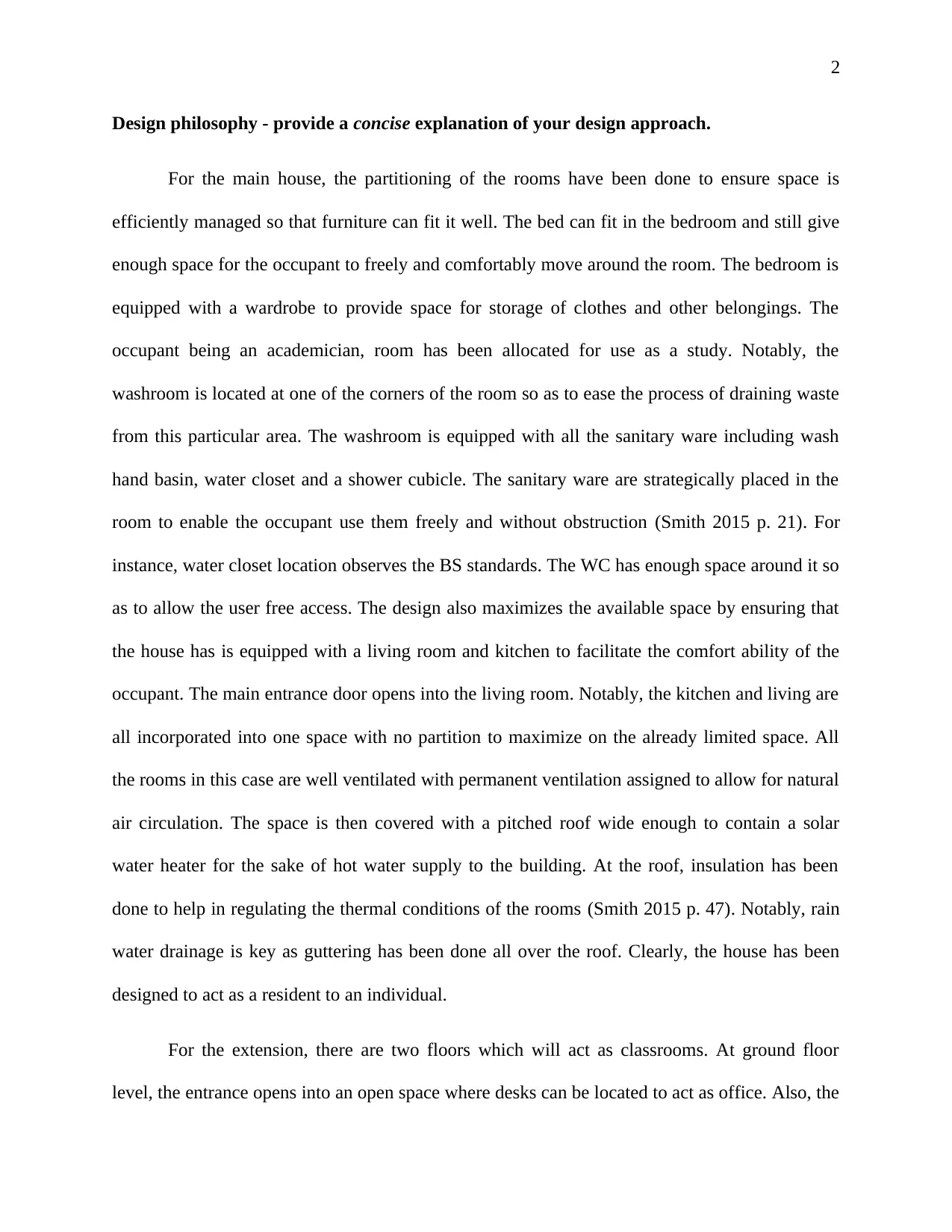
2
Design philosophy - provide a concise explanation of your design approach.
For the main house, the partitioning of the rooms have been done to ensure space is
efficiently managed so that furniture can fit it well. The bed can fit in the bedroom and still give
enough space for the occupant to freely and comfortably move around the room. The bedroom is
equipped with a wardrobe to provide space for storage of clothes and other belongings. The
occupant being an academician, room has been allocated for use as a study. Notably, the
washroom is located at one of the corners of the room so as to ease the process of draining waste
from this particular area. The washroom is equipped with all the sanitary ware including wash
hand basin, water closet and a shower cubicle. The sanitary ware are strategically placed in the
room to enable the occupant use them freely and without obstruction (Smith 2015 p. 21). For
instance, water closet location observes the BS standards. The WC has enough space around it so
as to allow the user free access. The design also maximizes the available space by ensuring that
the house has is equipped with a living room and kitchen to facilitate the comfort ability of the
occupant. The main entrance door opens into the living room. Notably, the kitchen and living are
all incorporated into one space with no partition to maximize on the already limited space. All
the rooms in this case are well ventilated with permanent ventilation assigned to allow for natural
air circulation. The space is then covered with a pitched roof wide enough to contain a solar
water heater for the sake of hot water supply to the building. At the roof, insulation has been
done to help in regulating the thermal conditions of the rooms (Smith 2015 p. 47). Notably, rain
water drainage is key as guttering has been done all over the roof. Clearly, the house has been
designed to act as a resident to an individual.
For the extension, there are two floors which will act as classrooms. At ground floor
level, the entrance opens into an open space where desks can be located to act as office. Also, the
Design philosophy - provide a concise explanation of your design approach.
For the main house, the partitioning of the rooms have been done to ensure space is
efficiently managed so that furniture can fit it well. The bed can fit in the bedroom and still give
enough space for the occupant to freely and comfortably move around the room. The bedroom is
equipped with a wardrobe to provide space for storage of clothes and other belongings. The
occupant being an academician, room has been allocated for use as a study. Notably, the
washroom is located at one of the corners of the room so as to ease the process of draining waste
from this particular area. The washroom is equipped with all the sanitary ware including wash
hand basin, water closet and a shower cubicle. The sanitary ware are strategically placed in the
room to enable the occupant use them freely and without obstruction (Smith 2015 p. 21). For
instance, water closet location observes the BS standards. The WC has enough space around it so
as to allow the user free access. The design also maximizes the available space by ensuring that
the house has is equipped with a living room and kitchen to facilitate the comfort ability of the
occupant. The main entrance door opens into the living room. Notably, the kitchen and living are
all incorporated into one space with no partition to maximize on the already limited space. All
the rooms in this case are well ventilated with permanent ventilation assigned to allow for natural
air circulation. The space is then covered with a pitched roof wide enough to contain a solar
water heater for the sake of hot water supply to the building. At the roof, insulation has been
done to help in regulating the thermal conditions of the rooms (Smith 2015 p. 47). Notably, rain
water drainage is key as guttering has been done all over the roof. Clearly, the house has been
designed to act as a resident to an individual.
For the extension, there are two floors which will act as classrooms. At ground floor
level, the entrance opens into an open space where desks can be located to act as office. Also, the
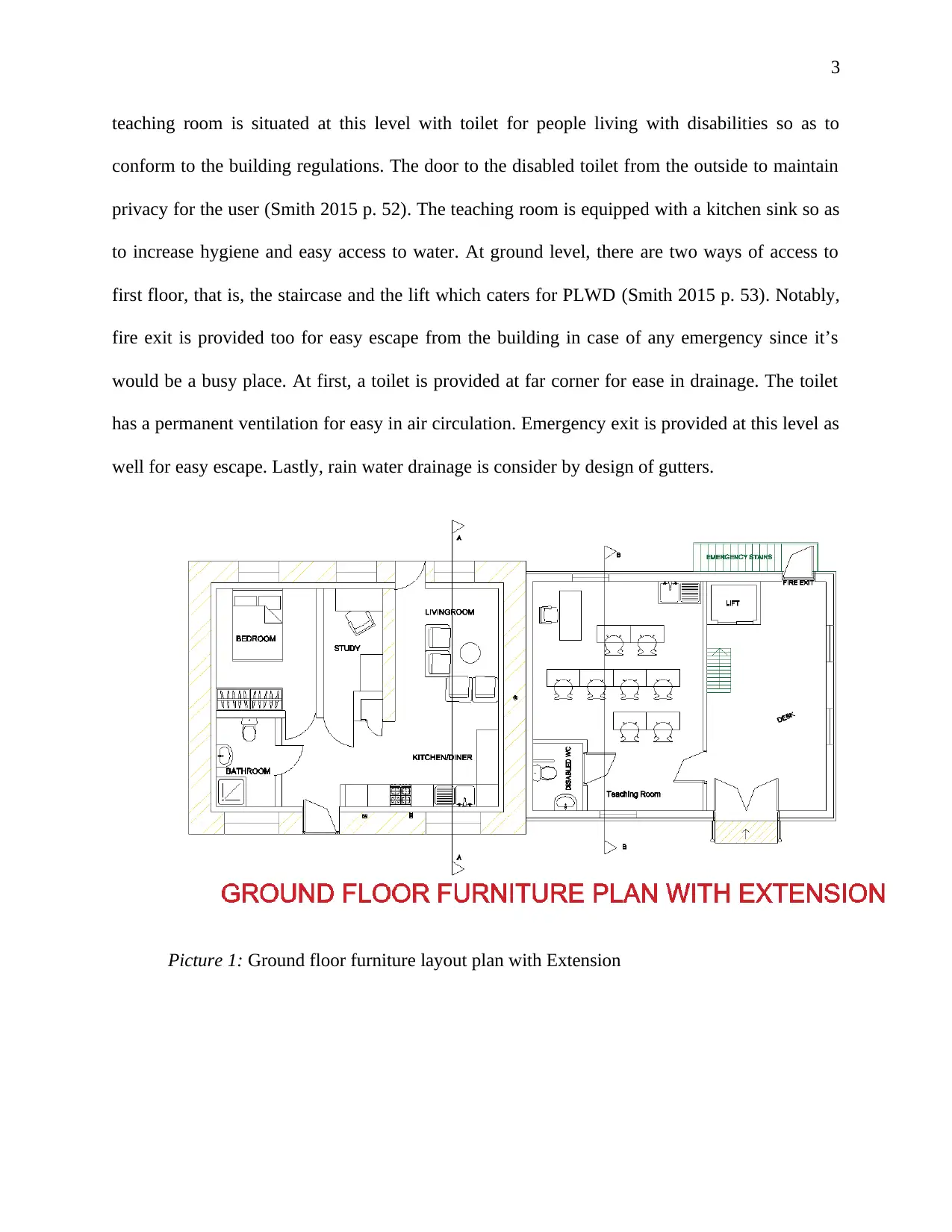
3
teaching room is situated at this level with toilet for people living with disabilities so as to
conform to the building regulations. The door to the disabled toilet from the outside to maintain
privacy for the user (Smith 2015 p. 52). The teaching room is equipped with a kitchen sink so as
to increase hygiene and easy access to water. At ground level, there are two ways of access to
first floor, that is, the staircase and the lift which caters for PLWD (Smith 2015 p. 53). Notably,
fire exit is provided too for easy escape from the building in case of any emergency since it’s
would be a busy place. At first, a toilet is provided at far corner for ease in drainage. The toilet
has a permanent ventilation for easy in air circulation. Emergency exit is provided at this level as
well for easy escape. Lastly, rain water drainage is consider by design of gutters.
Picture 1: Ground floor furniture layout plan with Extension
teaching room is situated at this level with toilet for people living with disabilities so as to
conform to the building regulations. The door to the disabled toilet from the outside to maintain
privacy for the user (Smith 2015 p. 52). The teaching room is equipped with a kitchen sink so as
to increase hygiene and easy access to water. At ground level, there are two ways of access to
first floor, that is, the staircase and the lift which caters for PLWD (Smith 2015 p. 53). Notably,
fire exit is provided too for easy escape from the building in case of any emergency since it’s
would be a busy place. At first, a toilet is provided at far corner for ease in drainage. The toilet
has a permanent ventilation for easy in air circulation. Emergency exit is provided at this level as
well for easy escape. Lastly, rain water drainage is consider by design of gutters.
Picture 1: Ground floor furniture layout plan with Extension
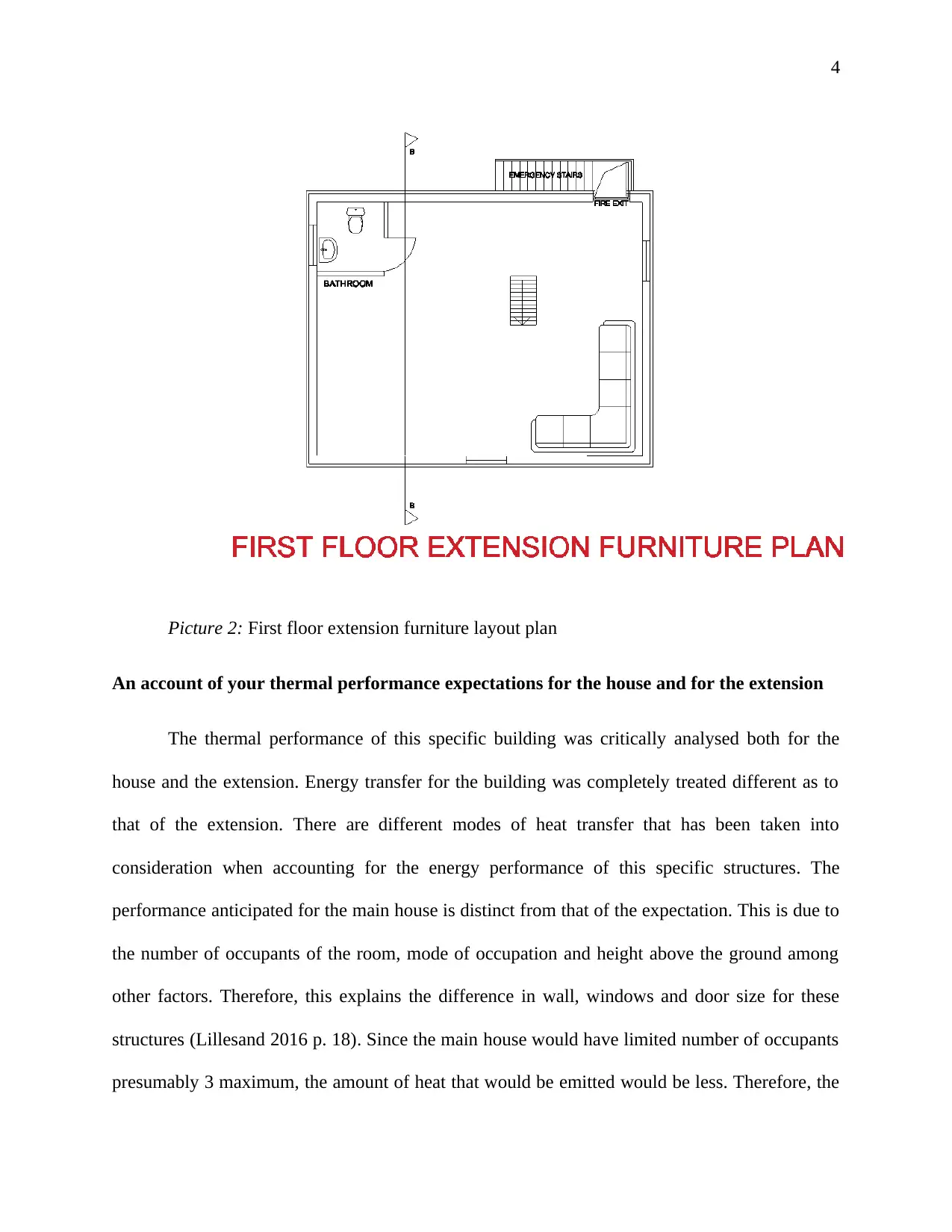
4
Picture 2: First floor extension furniture layout plan
An account of your thermal performance expectations for the house and for the extension
The thermal performance of this specific building was critically analysed both for the
house and the extension. Energy transfer for the building was completely treated different as to
that of the extension. There are different modes of heat transfer that has been taken into
consideration when accounting for the energy performance of this specific structures. The
performance anticipated for the main house is distinct from that of the expectation. This is due to
the number of occupants of the room, mode of occupation and height above the ground among
other factors. Therefore, this explains the difference in wall, windows and door size for these
structures (Lillesand 2016 p. 18). Since the main house would have limited number of occupants
presumably 3 maximum, the amount of heat that would be emitted would be less. Therefore, the
Picture 2: First floor extension furniture layout plan
An account of your thermal performance expectations for the house and for the extension
The thermal performance of this specific building was critically analysed both for the
house and the extension. Energy transfer for the building was completely treated different as to
that of the extension. There are different modes of heat transfer that has been taken into
consideration when accounting for the energy performance of this specific structures. The
performance anticipated for the main house is distinct from that of the expectation. This is due to
the number of occupants of the room, mode of occupation and height above the ground among
other factors. Therefore, this explains the difference in wall, windows and door size for these
structures (Lillesand 2016 p. 18). Since the main house would have limited number of occupants
presumably 3 maximum, the amount of heat that would be emitted would be less. Therefore, the
Secure Best Marks with AI Grader
Need help grading? Try our AI Grader for instant feedback on your assignments.
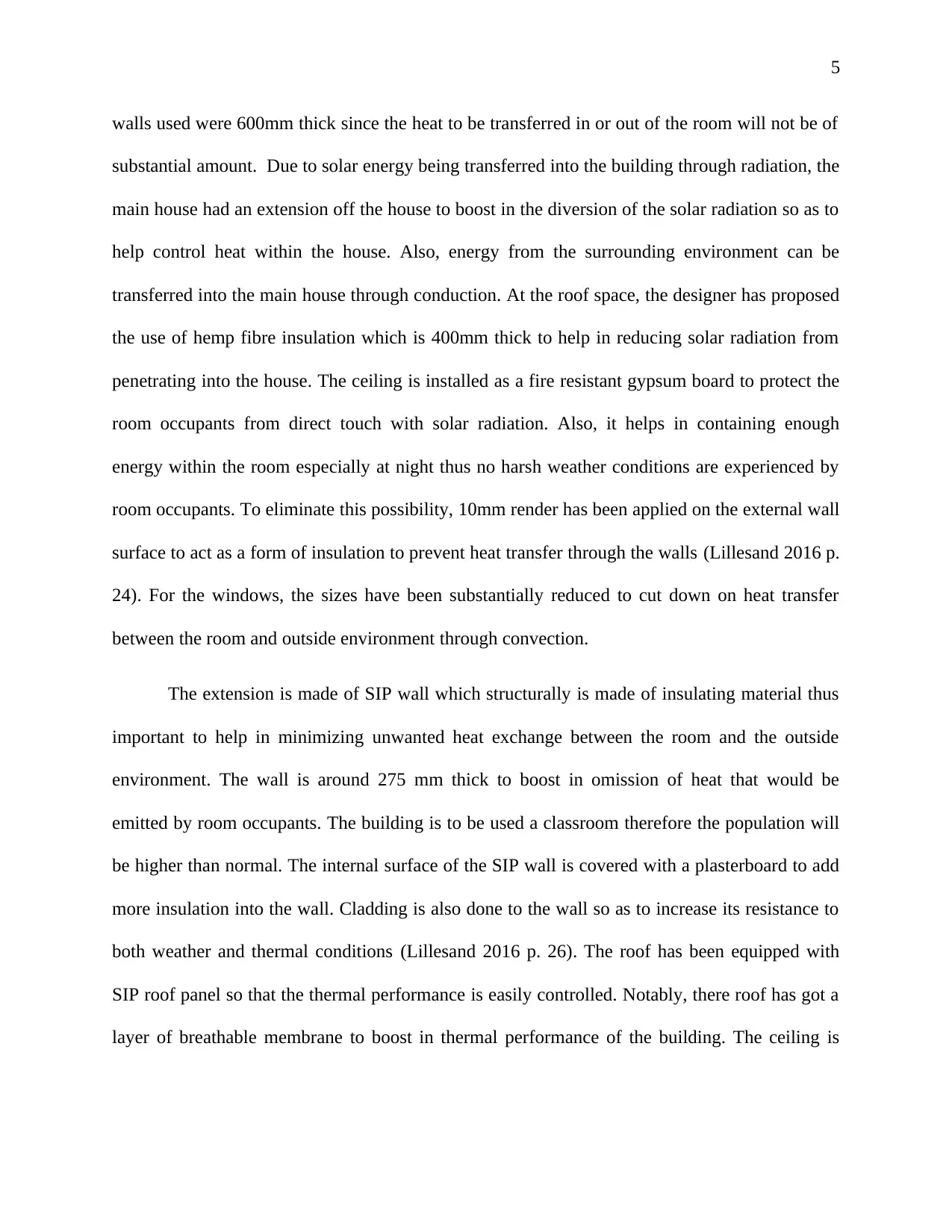
5
walls used were 600mm thick since the heat to be transferred in or out of the room will not be of
substantial amount. Due to solar energy being transferred into the building through radiation, the
main house had an extension off the house to boost in the diversion of the solar radiation so as to
help control heat within the house. Also, energy from the surrounding environment can be
transferred into the main house through conduction. At the roof space, the designer has proposed
the use of hemp fibre insulation which is 400mm thick to help in reducing solar radiation from
penetrating into the house. The ceiling is installed as a fire resistant gypsum board to protect the
room occupants from direct touch with solar radiation. Also, it helps in containing enough
energy within the room especially at night thus no harsh weather conditions are experienced by
room occupants. To eliminate this possibility, 10mm render has been applied on the external wall
surface to act as a form of insulation to prevent heat transfer through the walls (Lillesand 2016 p.
24). For the windows, the sizes have been substantially reduced to cut down on heat transfer
between the room and outside environment through convection.
The extension is made of SIP wall which structurally is made of insulating material thus
important to help in minimizing unwanted heat exchange between the room and the outside
environment. The wall is around 275 mm thick to boost in omission of heat that would be
emitted by room occupants. The building is to be used a classroom therefore the population will
be higher than normal. The internal surface of the SIP wall is covered with a plasterboard to add
more insulation into the wall. Cladding is also done to the wall so as to increase its resistance to
both weather and thermal conditions (Lillesand 2016 p. 26). The roof has been equipped with
SIP roof panel so that the thermal performance is easily controlled. Notably, there roof has got a
layer of breathable membrane to boost in thermal performance of the building. The ceiling is
walls used were 600mm thick since the heat to be transferred in or out of the room will not be of
substantial amount. Due to solar energy being transferred into the building through radiation, the
main house had an extension off the house to boost in the diversion of the solar radiation so as to
help control heat within the house. Also, energy from the surrounding environment can be
transferred into the main house through conduction. At the roof space, the designer has proposed
the use of hemp fibre insulation which is 400mm thick to help in reducing solar radiation from
penetrating into the house. The ceiling is installed as a fire resistant gypsum board to protect the
room occupants from direct touch with solar radiation. Also, it helps in containing enough
energy within the room especially at night thus no harsh weather conditions are experienced by
room occupants. To eliminate this possibility, 10mm render has been applied on the external wall
surface to act as a form of insulation to prevent heat transfer through the walls (Lillesand 2016 p.
24). For the windows, the sizes have been substantially reduced to cut down on heat transfer
between the room and outside environment through convection.
The extension is made of SIP wall which structurally is made of insulating material thus
important to help in minimizing unwanted heat exchange between the room and the outside
environment. The wall is around 275 mm thick to boost in omission of heat that would be
emitted by room occupants. The building is to be used a classroom therefore the population will
be higher than normal. The internal surface of the SIP wall is covered with a plasterboard to add
more insulation into the wall. Cladding is also done to the wall so as to increase its resistance to
both weather and thermal conditions (Lillesand 2016 p. 26). The roof has been equipped with
SIP roof panel so that the thermal performance is easily controlled. Notably, there roof has got a
layer of breathable membrane to boost in thermal performance of the building. The ceiling is
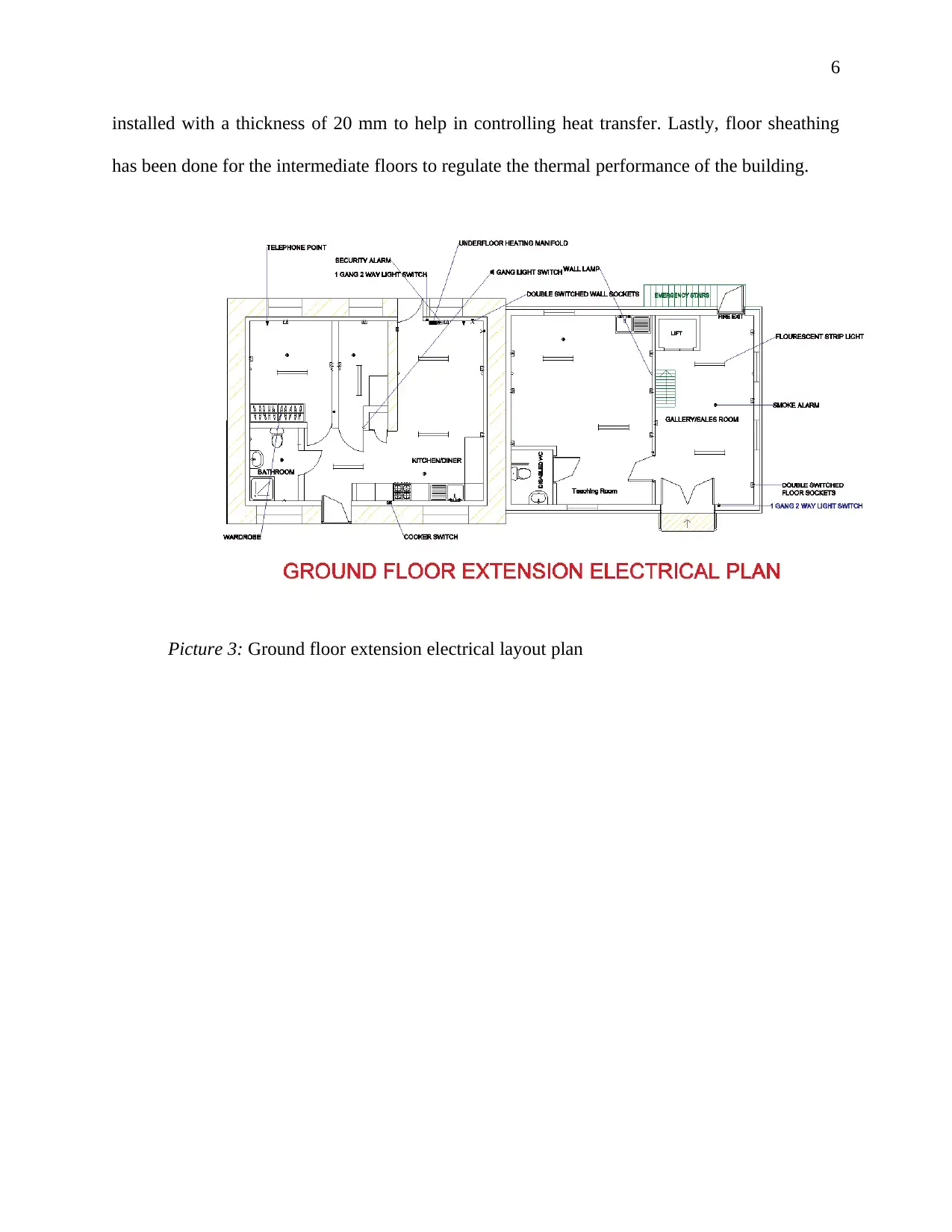
6
installed with a thickness of 20 mm to help in controlling heat transfer. Lastly, floor sheathing
has been done for the intermediate floors to regulate the thermal performance of the building.
Picture 3: Ground floor extension electrical layout plan
installed with a thickness of 20 mm to help in controlling heat transfer. Lastly, floor sheathing
has been done for the intermediate floors to regulate the thermal performance of the building.
Picture 3: Ground floor extension electrical layout plan
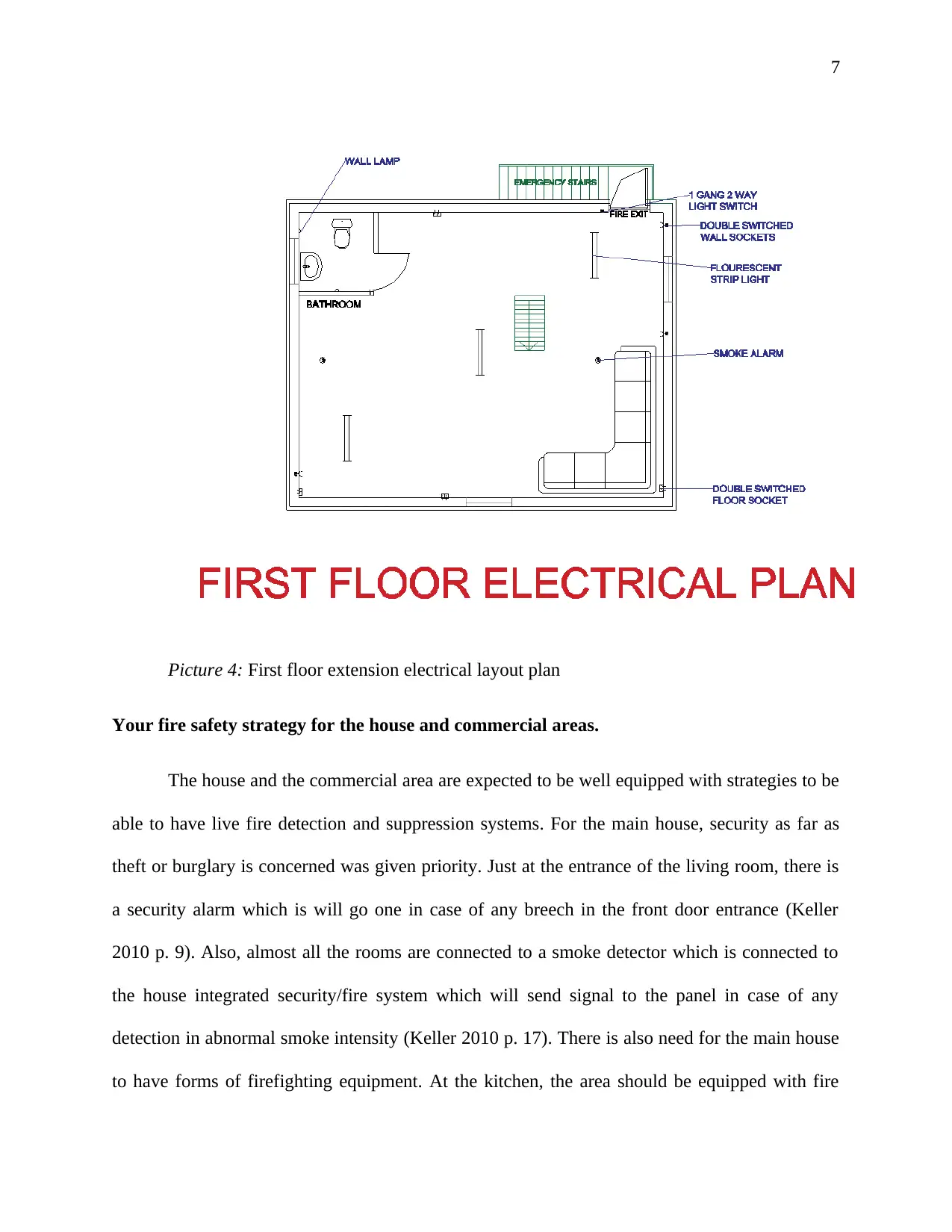
7
Picture 4: First floor extension electrical layout plan
Your fire safety strategy for the house and commercial areas.
The house and the commercial area are expected to be well equipped with strategies to be
able to have live fire detection and suppression systems. For the main house, security as far as
theft or burglary is concerned was given priority. Just at the entrance of the living room, there is
a security alarm which is will go one in case of any breech in the front door entrance (Keller
2010 p. 9). Also, almost all the rooms are connected to a smoke detector which is connected to
the house integrated security/fire system which will send signal to the panel in case of any
detection in abnormal smoke intensity (Keller 2010 p. 17). There is also need for the main house
to have forms of firefighting equipment. At the kitchen, the area should be equipped with fire
Picture 4: First floor extension electrical layout plan
Your fire safety strategy for the house and commercial areas.
The house and the commercial area are expected to be well equipped with strategies to be
able to have live fire detection and suppression systems. For the main house, security as far as
theft or burglary is concerned was given priority. Just at the entrance of the living room, there is
a security alarm which is will go one in case of any breech in the front door entrance (Keller
2010 p. 9). Also, almost all the rooms are connected to a smoke detector which is connected to
the house integrated security/fire system which will send signal to the panel in case of any
detection in abnormal smoke intensity (Keller 2010 p. 17). There is also need for the main house
to have forms of firefighting equipment. At the kitchen, the area should be equipped with fire
Paraphrase This Document
Need a fresh take? Get an instant paraphrase of this document with our AI Paraphraser
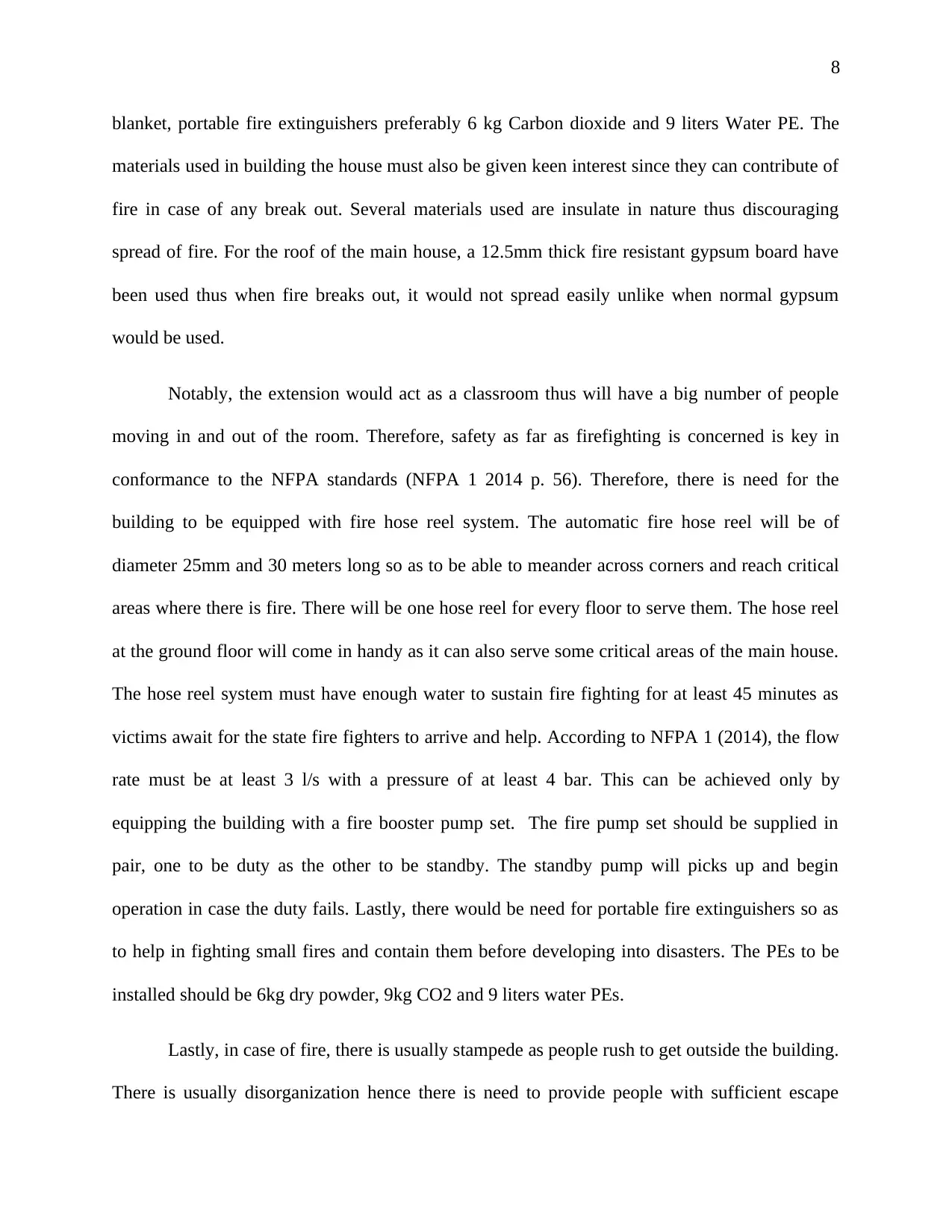
8
blanket, portable fire extinguishers preferably 6 kg Carbon dioxide and 9 liters Water PE. The
materials used in building the house must also be given keen interest since they can contribute of
fire in case of any break out. Several materials used are insulate in nature thus discouraging
spread of fire. For the roof of the main house, a 12.5mm thick fire resistant gypsum board have
been used thus when fire breaks out, it would not spread easily unlike when normal gypsum
would be used.
Notably, the extension would act as a classroom thus will have a big number of people
moving in and out of the room. Therefore, safety as far as firefighting is concerned is key in
conformance to the NFPA standards (NFPA 1 2014 p. 56). Therefore, there is need for the
building to be equipped with fire hose reel system. The automatic fire hose reel will be of
diameter 25mm and 30 meters long so as to be able to meander across corners and reach critical
areas where there is fire. There will be one hose reel for every floor to serve them. The hose reel
at the ground floor will come in handy as it can also serve some critical areas of the main house.
The hose reel system must have enough water to sustain fire fighting for at least 45 minutes as
victims await for the state fire fighters to arrive and help. According to NFPA 1 (2014), the flow
rate must be at least 3 l/s with a pressure of at least 4 bar. This can be achieved only by
equipping the building with a fire booster pump set. The fire pump set should be supplied in
pair, one to be duty as the other to be standby. The standby pump will picks up and begin
operation in case the duty fails. Lastly, there would be need for portable fire extinguishers so as
to help in fighting small fires and contain them before developing into disasters. The PEs to be
installed should be 6kg dry powder, 9kg CO2 and 9 liters water PEs.
Lastly, in case of fire, there is usually stampede as people rush to get outside the building.
There is usually disorganization hence there is need to provide people with sufficient escape
blanket, portable fire extinguishers preferably 6 kg Carbon dioxide and 9 liters Water PE. The
materials used in building the house must also be given keen interest since they can contribute of
fire in case of any break out. Several materials used are insulate in nature thus discouraging
spread of fire. For the roof of the main house, a 12.5mm thick fire resistant gypsum board have
been used thus when fire breaks out, it would not spread easily unlike when normal gypsum
would be used.
Notably, the extension would act as a classroom thus will have a big number of people
moving in and out of the room. Therefore, safety as far as firefighting is concerned is key in
conformance to the NFPA standards (NFPA 1 2014 p. 56). Therefore, there is need for the
building to be equipped with fire hose reel system. The automatic fire hose reel will be of
diameter 25mm and 30 meters long so as to be able to meander across corners and reach critical
areas where there is fire. There will be one hose reel for every floor to serve them. The hose reel
at the ground floor will come in handy as it can also serve some critical areas of the main house.
The hose reel system must have enough water to sustain fire fighting for at least 45 minutes as
victims await for the state fire fighters to arrive and help. According to NFPA 1 (2014), the flow
rate must be at least 3 l/s with a pressure of at least 4 bar. This can be achieved only by
equipping the building with a fire booster pump set. The fire pump set should be supplied in
pair, one to be duty as the other to be standby. The standby pump will picks up and begin
operation in case the duty fails. Lastly, there would be need for portable fire extinguishers so as
to help in fighting small fires and contain them before developing into disasters. The PEs to be
installed should be 6kg dry powder, 9kg CO2 and 9 liters water PEs.
Lastly, in case of fire, there is usually stampede as people rush to get outside the building.
There is usually disorganization hence there is need to provide people with sufficient escape

9
ways. Therefore, apart from the normal doors, it is good practice that the house is equipped with
fire exit doors to be opened for people to use during fire break out. The contractor must also do
proper fire signage which are clear and easy to read.
Picture 5: Main House Section showing material choice
ways. Therefore, apart from the normal doors, it is good practice that the house is equipped with
fire exit doors to be opened for people to use during fire break out. The contractor must also do
proper fire signage which are clear and easy to read.
Picture 5: Main House Section showing material choice
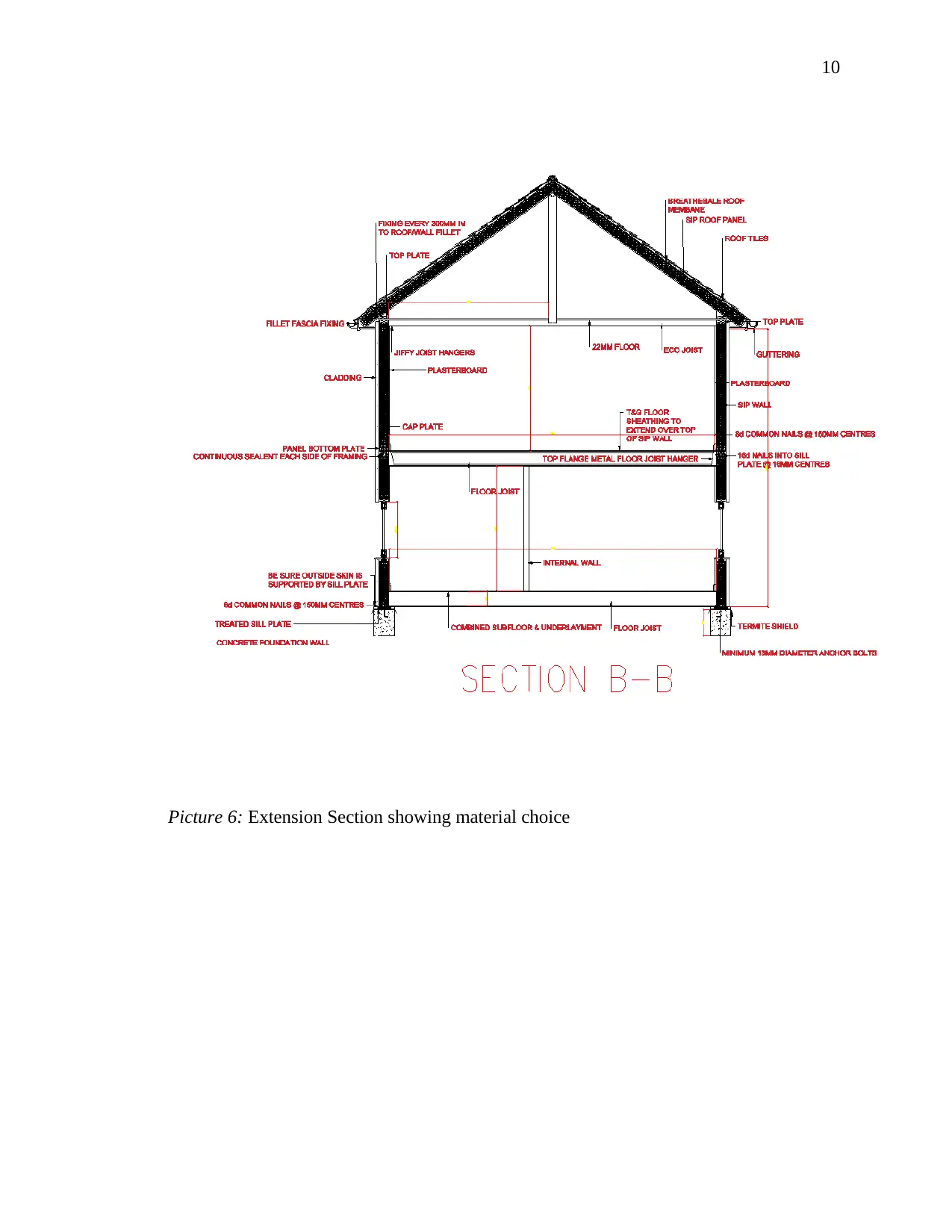
10
Picture 6: Extension Section showing material choice
Picture 6: Extension Section showing material choice
Secure Best Marks with AI Grader
Need help grading? Try our AI Grader for instant feedback on your assignments.

11
References
Keller, K., 2010. Electrical Safety Code Manual: A Plain Language Guide to National Electrical
Code, OSHA and NFPA 70E. Butterworth-Heinemann.
Lillesand, T., 2016. Ashrea handbook. 10th ed.: Ashrae.
NFPA 1., 2014. Quincy, Mass. The Association.
Smith, M., 2015. Using the Building Regulations. 5th ed. Burlington: Elsevier.
References
Keller, K., 2010. Electrical Safety Code Manual: A Plain Language Guide to National Electrical
Code, OSHA and NFPA 70E. Butterworth-Heinemann.
Lillesand, T., 2016. Ashrea handbook. 10th ed.: Ashrae.
NFPA 1., 2014. Quincy, Mass. The Association.
Smith, M., 2015. Using the Building Regulations. 5th ed. Burlington: Elsevier.
1 out of 11
Your All-in-One AI-Powered Toolkit for Academic Success.
+13062052269
info@desklib.com
Available 24*7 on WhatsApp / Email
![[object Object]](/_next/static/media/star-bottom.7253800d.svg)
Unlock your academic potential
© 2024 | Zucol Services PVT LTD | All rights reserved.

